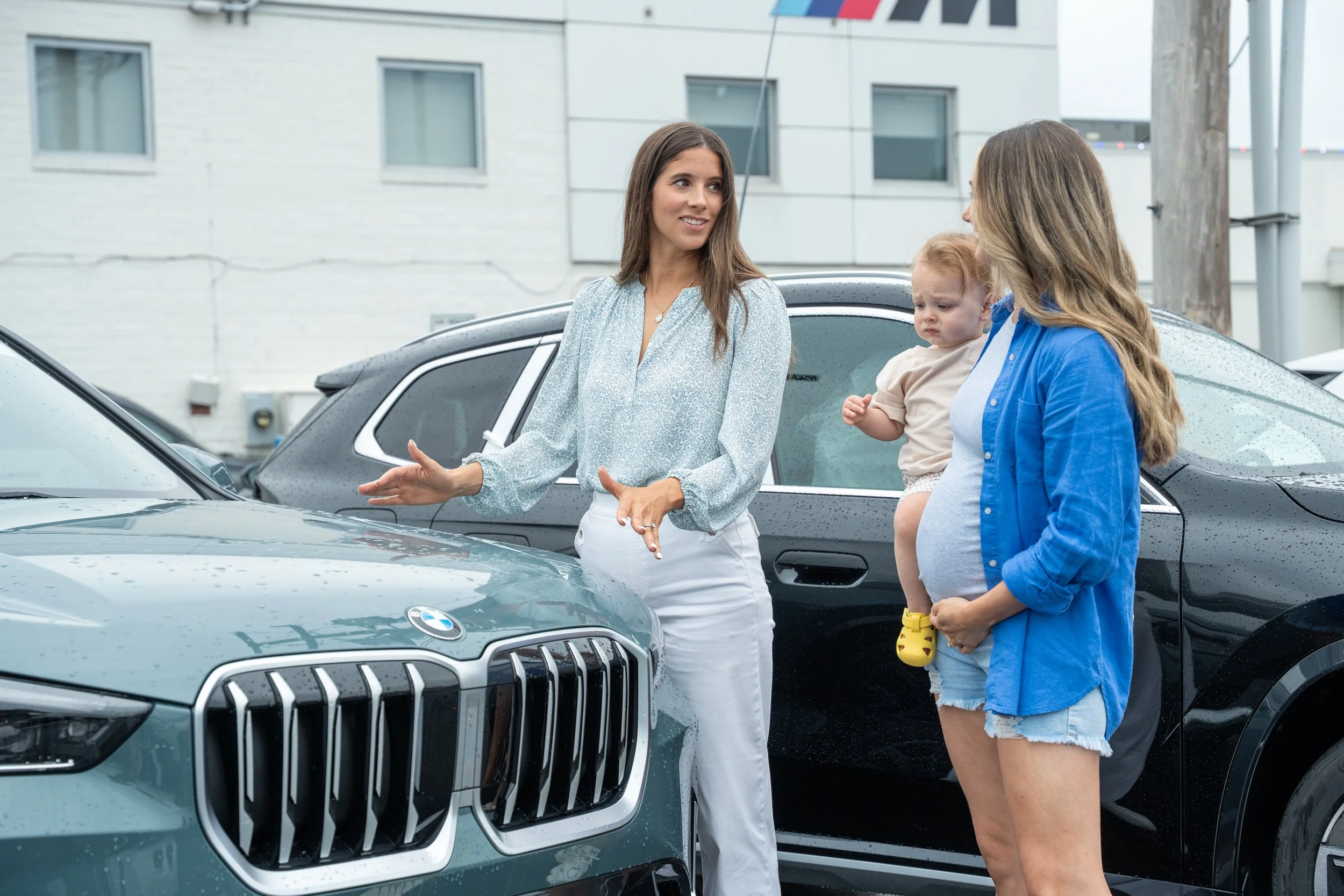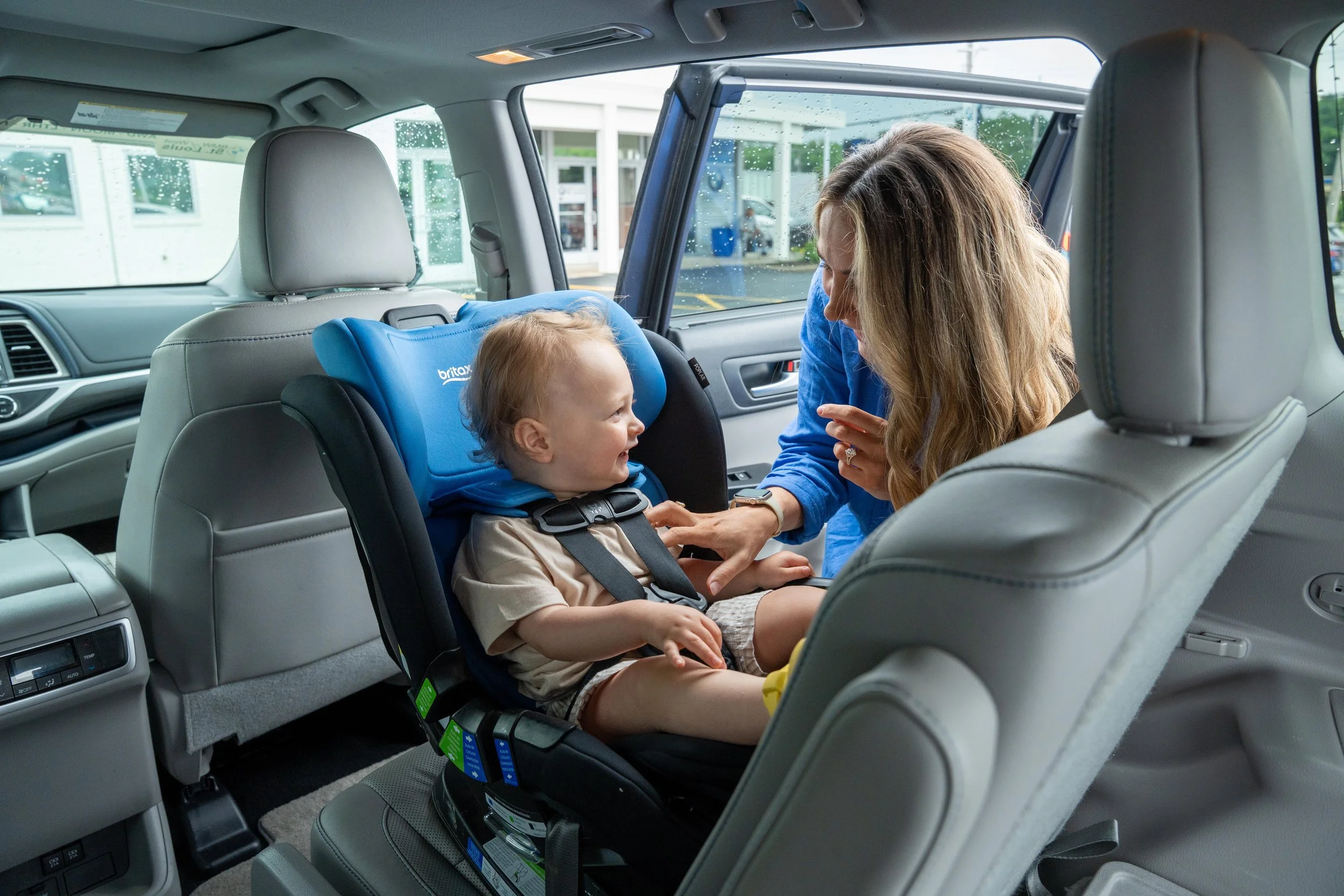GMC Yukon vs Chevy Tahoe: Which Full-Size SUV Is Right For Your Family?
Trying to decide between two of the most iconic full-size SUVs on the market?
The GMC Yukon and Chevy Tahoe have long been favorites for families who need space, comfort, and serious capability. While these siblings share a lot under the skin, they each bring their own style, features, and family appeal to the table.
If you’re new here-welcome! I’m Kelly, the Car Mom. As a Child Passenger Safety Technician (CPST), mom of four, and car enthusiast, my goal is to help you find the best car for your family. In this guide, I’ll break down everything you need to know about the 2025 Yukon and Tahoe, from pricing to car seat fit, so you can pick the SUV that’s right for your crew.
Both of these SUVs are excellent choices for big families, road trips, and anyone who needs maximum versatility. But there are a few key differences you’ll want to know before you buy.
My honest take on these cars…
The Tahoe offers great safety features, updated tech, and flexible seating. For families who are more focused on space, function, and value, the Tahoe is a smart, family-first pick. In 2025 Chevy finally brought it with a massive new display, and I was genuinely impressed—this might be one of my favorite infotainment setups across any lineup.
The Yukon overall leans more luxury. Especially in trims like the Denali, you’re getting upgraded interior finishes, a quieter ride, and more of those polished, premium touches. If your budget allows and you want that “wow” factor every time you slide into the driver’s seat, the Yukon’s going to deliver.
They both have identical car seat hardware setups and 3rd row access making the only real deciding factors your budget and your vibe!
Have you considered an extended wheelbase?
If you’re planning to use the third row often, it’s important to know that trunk space in the standard Tahoe and Yukon can feel pretty limited—something many families don’t realize until they’re packing for a road trip or loading up a double stroller. That’s where the extended-wheelbase versions—the Chevy Suburban and GMC Yukon XL—really shine.
They add over 15 inches in length and give you a lot more usable space behind the third row!
If car seat flexibility is also high on your list, be sure to check out the Ford Expedition MAX. It offers more LATCH and tether points than most full-size SUVs, plus a car seat tilt feature that makes third-row access easier without uninstalling a forward-facing seat. It’s actually my personal favorite family SUV and what I drive everyday!
GMC Yukon vs Chevy Tahoe: What I’m Comparing
Pricing and value
Fuel economy
Safety and reliability
Car seat compatibility
Third-row access and comfort
Trunk space and family practicality
Technology and infotainment
Pricing and Value
Chevy Tahoe: Starts at about $58,500 for the LS trim. Standard features include an 8-inch touchscreen, wireless Apple CarPlay/Android Auto, tri-zone climate control, and Chevy Safety Assist. Higher trims add leather, a panoramic sunroof, and a 10.2-inch touchscreen.
GMC Yukon: Starts at $68,895 for the SLE trim, with a more premium look and feel right from the base model. The Yukon comes standard with a 12-inch digital gauge cluster, a 10.2-inch touchscreen, and more upscale materials. The Denali and Denali Ultimate trims deliver true luxury, with open-pore wood, massaging seats, and advanced tech.
Fuel Economy Breakdown
Chevy Tahoe: The Chevy Tahoe gives you three engine choices:
A standard 5.3L V8 with 355 horsepower — it’s the most common and gets about 15 mpg in the city and 20 on the highway.
A more powerful 6.2L V8 with 433 horsepower — great if you want extra power.
A 3.0L turbo-diesel — it’s the best on gas, with up to 21 mpg in the city and 27 on the highway.
Most Tahoes come with the 5.3L V8, but if fuel efficiency is important to you, the diesel is your best bet.
GMC Yukon: Shares the same engine lineup and fuel economy as the Tahoe, with minor differences depending on trim and options. The Yukon Denali and Denali Ultimate offer the 6.2L V8 as standard, while lower trims use the 5.3L V8 or the diesel.
Towing Capacity
Both SUVs can tow up to 8,400 pounds when properly equipped, making them ideal for families with boats, campers, or trailers.
The Tahoe takes a slight lead with its available diesel and 6.2L V8, but both are strong performers for family adventures.
Smartphone Integration and Available Tech Features
Both SUVs offer wireless Apple CarPlay and Android Auto, multiple USB ports, available Wi-Fi hotspot, and premium audio options (Bose in Tahoe, Bose or AKG in Yukon Denali Ultimate).
The Yukon’s Denali models offer a surround-view camera, rear-seat entertainment, and massaging seats for a truly upscale experience. The Tahoe, while less luxurious, still offers all the tech features you’d want in a family car.
Let’s Talk Safety and Reliability
While neither are IIHS Safety Picks, Both the Yukon and Tahoe come standard with a full suite of driver-assist features like:
Automatic emergency braking
Forward collision alert
Lane keep assist
Blind-spot monitoring
Rear cross-traffic alert.
Advanced parking sensors and surround-view cameras are available on higher trims.
The Yukon’s Denali Ultimate and the Tahoe High Country offer the most advanced safety tech, including adaptive cruise control and enhanced automatic parking assist.
Both SUVs check all the safety boxes, which is a huge win for families. The Tahoe and Yukon are neck and neck here, but if you’re going all-in on a top trim, Yukon’s packs in just a little more tech.
Car Seat Compatibility


Second Row: Both the Yukon and Tahoe are super car seat-friendly. In the second row—whether you choose a bench or captain’s chairs—you’ll get two sets of lower LATCH anchors and three top tethers. The anchors are exposed and easy to use, making installs straightforward.
Third Row: In the third row, neither SUV offers lower anchors, but they do have three top tether anchors, which is great if you're installing forward-facing seats or boosters. Just know you’ll need to use the seatbelt and tether, since there are no lower anchors back there.
The second row in both vehicles is wide, so even bulky rear-facing car seats fit without eating up too much front seat space. If you opt for a bench, you may even be able to fit three across in many cases!
Both the Yukon and Tahoe are great for car seats, but since I’ve personally had success fitting three across in the Tahoe’s bench seat, I think it gives families a little more flexibility—especially if you want to maximize trunk space too.
Yukon Takes The Win For Third-Row Access
Both the Yukon and Tahoe feature large rear doors and second-row seats that slide and fold forward with one touch, making it easy for kids and adults to access the third row.
Both SUVs offer nearly identical third-row legroom (about 35 inches) and headroom, making them comfortable for kids and even adults on shorter trips. The Yukon’s Denali trim offers extra touches like executive captain’s chairs and more luxurious materials, while the Tahoe’s third row is just as usable but a bit simpler.
Trunk Space and Family Practicality
Behind Third Row: Both offer about 25.5 cubic feet-enough for a week’s worth of groceries or several suitcases.
Behind Second Row: Both expand to over 72 cubic feet with the third row folded.
Maximum Cargo: The Tahoe edges out the Yukon with 122.9 cubic feet (vs. 122.2 in the Yukon) when all seats are folded, but the difference is negligible.
Loading and Unloading
Both SUVs have a flat load floor, wide cargo opening, power liftgate, and underfloor storage. The Yukon XL and Tahoe Suburban models offer even more space for families who need it. The Yukon’s slightly taller height means you get a bit more vertical cargo room, while the Tahoe’s longer body is better for longer items.
It’s a close call, but the Tahoe wins for cargo flexibility, especially if you’re hauling long strollers, sports gear, or Costco hauls. That extra length makes a big difference in real life.
Which Has Better Technology and Infotainment?
Chevy Tahoe: Base trims offer an 8-inch touchscreen; higher trims get a 10.2-inch display. The interface is straightforward and user-friendly, with physical knobs for volume and tuning.
GMC Yukon: Starts with a 10.2-inch touchscreen and a 12-inch digital gauge cluster even on the base model. Denali trims add a head-up display and a more advanced infotainment suite. The Yukon’s system feels more modern and premium, especially in higher trims.
Warranty and Roadside Assistance
Both SUVs offer a 3-year/36,000-mile basic warranty and a 5-year/60,000-mile powertrain warranty. GMC and Chevy also include complimentary maintenance for the first year. The Yukon’s higher starting price reflects its extra standard features and more premium interior, while the Tahoe offers a broader range of trims for different budgets.
If you’re budget-conscious and want more flexibility, the Tahoe gives you more trim options to work with. But if you’re after a more premium feel right out of the gate, the Yukon’s got the edge.
GMC Yukon vs Chevy Tahoe: Which Family SUV Is Right For You?
Choose The Chevy Tahoe If:
You want the most cargo space and seating flexibility for the price.
You prefer a more budget-friendly option with plenty of available features.
You like a classic, rugged SUV look and straightforward controls.
You want standard safety features like automatic emergency braking and lane keep assist.
You want an SUV that drives big but feels functional for family life.
Choose The GMC Yukon If:
You want a more premium interior, advanced tech, and luxury touches (especially Denali trims).
You value a smoother, quieter ride with features like air suspension and massaging seats.
You want a commanding, upscale appearance and extra attention to detail.
The Bottom Line
Both the 2025 GMC Yukon and 2025 Chevy Tahoe are top-tier choices for families who need space, versatility, and confidence on the road. The Tahoe stands out for its value and flexibility, while the Yukon shines for its luxury and refinement-especially in Denali trims. Consider your family’s needs, budget, and style preferences, and test drive both to see which fits your routine best. No matter which you choose, you’ll be getting one of the best full-size SUVs for families today.
Which full-size SUV would you choose? Let me know in the comments! And to keep up with all the latest family car reviews and tips, check out my recent posts.





